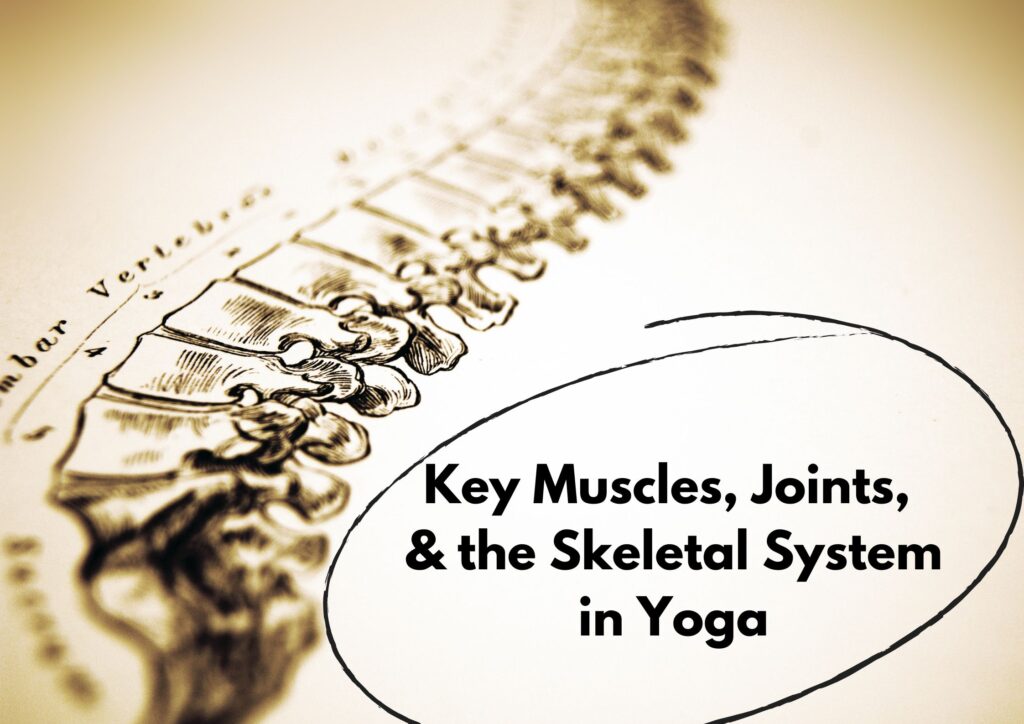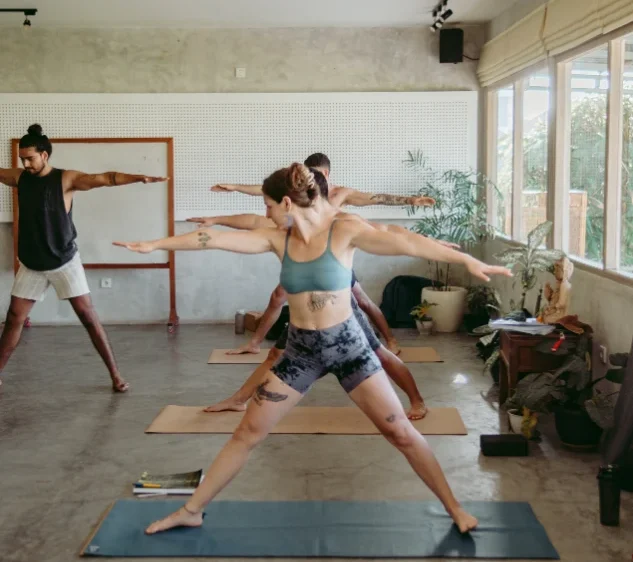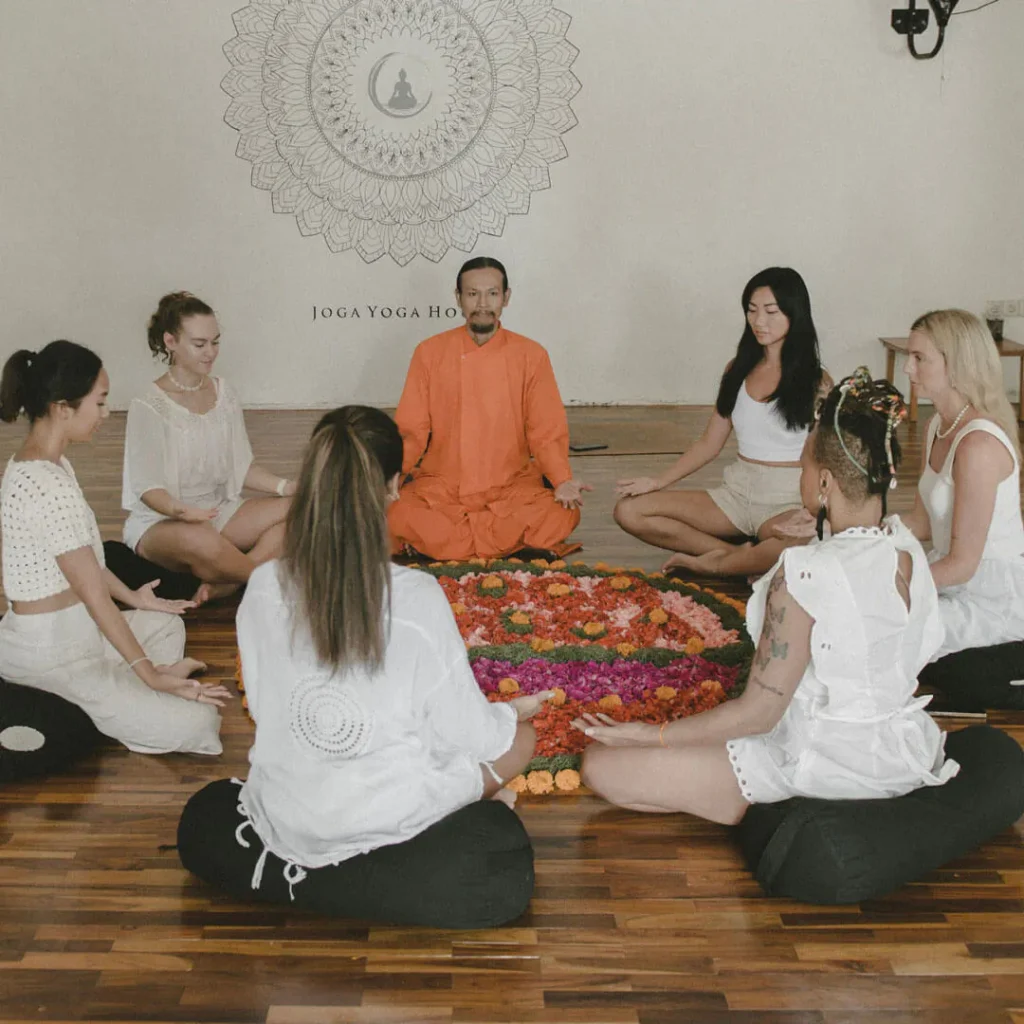Introduction to Yoga Anatomy
Yoga anatomy studies the body’s structure as it relates to yoga practice. This includes understanding how muscles, bones, and joints function and interact during yoga poses. A thorough understanding of yoga anatomy is required for achieving proper body alignment, increasing the effectiveness of yoga practice, and avoiding injuries. Additionally, combining this knowledge with a deep understanding of Yoga Philosophy can further enrich your practice by integrating yoga’s physical and philosophical aspects.
The Basics of Yoga Anatomy
Yoga anatomy rests on several key pillars:
- Muscle & Bone Harmony: Discover which muscles are activated and how bones align in different poses to understand movement patterns better.
- Joint Exploration: Explore the range of motion in your joints and how they function effectively within various yoga postures.
- Mastering Alignment: Learn how to position your body correctly to unlock the full benefits of each pose and avoid strain or injury.
Why Yoga Anatomy is Important for Your Practice
Understanding yoga anatomy empowers you in several ways:
- Injury Prevention: Knowing your body’s limits and capabilities helps you avoid overexertion and misalignment, significantly reducing the risk of injuries.
- Elevating Your Practice: With anatomical knowledge, you can perform more precise adjustments and engage in poses with greater depth, leading to a more fulfilling practice.
- Effective Teaching (for Instructors): Understanding anatomy equips yoga instructors to provide accurate cues and modifications for students, ensuring a safe and effective practice for everyone. For more insights into nurturing souls through yoga teaching, explore our guide on yoga teaching.
Joga Yoga’s Approach to Yoga Anatomy
At Joga Yoga, anatomy is integrated seamlessly into our teacher training programs. Trainees engage in detailed modules on anatomy and physiology, gaining a complete understanding of how the body functions in harmony with yoga practice. This knowledge empowers them to teach with confidence and precision, fostering a safe and transformative journey for their students.
By including detailed anatomical studies in the curriculum, Joga Yoga ensures graduates are well-equipped to apply this knowledge in their teaching and personal practice. This focus enhances the quality of instruction and fosters a deeper connection to the physical aspects of your yoga practice.
What is Yoga Anatomy?
Yoga anatomy is the study of the structure and function of the body as it pertains to yoga practice. It encompasses understanding the physical body, including the bones, muscles, joints, and other tissues, and how they work together during yoga poses. This field of study provides insights into the mechanics of movement, alignment, and the physiological benefits of yoga.
Components of Yoga Anatomy
Yoga anatomy covers several critical components:
- Bones: The skeletal system forms the foundation of the body and provides the structure for movement. Knowing the location and function of bones helps in understanding alignment in yoga poses.
- Muscles: Muscles facilitate movement and stability. Understanding which muscles are engaged in different poses can help improve practice and prevent injuries.
- Joints: Joints are where bones meet and enable movement. Understanding joint function and range of motion is critical for safely executing poses.
- Connective Tissues: This includes ligaments, tendons, and fascia, which support and stabilize the body. Understanding these tissues helps in maintaining flexibility and preventing strain.
Application in Yoga Practice
Applying the principles of yoga anatomy to practice involves:
- Alignment: Ensuring proper alignment in poses to maximize benefits and reduce the risk of injury.
- Modifications: Making adjustments based on individual anatomical differences to accommodate varying levels of flexibility and strength.
- Injury Prevention: Using anatomical knowledge to avoid overextension and improper movements that can lead to injuries.
Joga Yoga’s Emphasis on Anatomy
At Joga Yoga, anatomy is a cornerstone of the teacher training curriculum. The program emphasizes the importance of understanding the body’s structure and function to teach yoga safely and effectively. Trainees learn to:
- Analyze Poses: Break down yoga poses to understand which muscles and joints are involved.
- Provide Adjustments: Offer modifications and adjustments to students based on their anatomical needs.
- Enhance Teaching: Use anatomical knowledge to create effective and safe yoga sequences.
For a comprehensive overview of Joga Yoga’s approach to integrating anatomy into their training programs, check out their Comprehensive Guide to Joga Yoga’s Teacher Training Program.
Anatomy or Physiology?

Anatomy refers to the study of the physical structure of the body, including bones, muscles, and joints.
Physiology, on the other hand, examines the functions and processes of the body systems. It explores how these systems—such as the respiratory, circulatory, and nervous systems—work during yoga practice to support movement, breath control, and overall health.
Differences and Relevance to Yoga Practice
- Anatomy: In yoga, knowing anatomy helps practitioners understand alignment, identify the muscles engaged in poses, and make necessary adjustments to prevent injuries.
- Physiology: Understanding physiology is essential for comprehending how yoga impacts bodily functions, such as improving circulation, enhancing respiratory efficiency, and promoting relaxation through the nervous system.
Joga Yoga’s Curriculum
Joga Yoga integrates both anatomy and physiology into its teacher training programs. Trainees learn:
- Anatomy: Detailed study of the body’s structure, focusing on alignment and muscle engagement in various yoga poses.
- Physiology: Exploration of how yoga affects body systems, emphasizing the benefits of yoga practices on health and well-being.
For those considering training in Bali, Joga Yoga offers an immersive experience. Explore our Yoga Teacher Training in Bali Guide to learn more about the benefits and details of training in this serene location.
The Language of Yoga Anatomy
Familiarity with anatomical terminology helps in understanding and teaching yoga. Key terms include:
- Flexion and Extension: Movements that decrease or increase the angle between body parts (e.g., bending and straightening the knee).
- Abduction and Adduction: Movements away from or toward the body’s midline (e.g., lifting arms sideways or bringing them down).
- Rotation: Movement around an axis (e.g., twisting the spine).
Joga Yoga’s Approach to Yoga Anatomy
At Joga Yoga, the curriculum emphasizes the importance of anatomy for safety and effectiveness. Trainees learn:
- Safety Techniques: How to use anatomical knowledge to prevent injuries and ensure safe practice.
- Alignment Principles: Applying anatomical terms to achieve proper alignment in poses.
- Effective Teaching: Using anatomy to give clear and accurate instructions to students.
The Fundamental Principle: Everybody’s Anatomy is Different
Every individual’s anatomy is unique, which significantly impacts how yoga poses are experienced and performed. Recognizing and adapting to these differences is important for a safe and effective yoga practice.
How Anatomical Differences Affect Yoga Practice
- Range of Motion: Variations in joint flexibility and muscle length affect how deeply one can move into a pose.
- Bone Structure: Differences in skeletal structure, such as hip socket depth and femur length, influence how certain poses are executed.
- Muscle Strength and Flexibility: Individual differences in muscle strength and flexibility can affect balance, stability, and alignment in poses.
Adapting Yoga Practice to Individual Anatomy
- Modifications: Offering variations and props to accommodate different body types and flexibility levels.
- Personal Adjustments: Providing personalized adjustments to help each practitioner achieve proper alignment and maximize benefits.
- Awareness: Encouraging self-awareness and listening to one’s body to avoid pushing beyond safe limits.
Key Muscles, Joints, and the Skeletal System in Yoga
A thorough understanding of yoga anatomy is required for proper body alignment, increased yoga practice effectiveness, and injury prevention.

Primary Muscle Groups Engaged in Common Yoga Poses
- Core Muscles: These include the abdominal, obliques, and lower back muscles, which are required for balance and stability in poses such as Plank and Boat Pose.
- Leg Muscles: The quadriceps, hamstrings, calves, and glutes are heavily engaged in standing poses such as Warrior I and II, providing strength and support.
- Arm and Shoulder Muscles: The deltoids, biceps, triceps, and forearm muscles are required for poses that entail weight bearing on the arms, such as Downward Dog and Chaturanga.
- Back Muscles: The trapezius, latissimus dorsi, and erector spinae play significant roles in backbends and twists, aiding in flexibility and support.
Key Joints Involved in Yoga
- Shoulder Joints: Vital for arm movements and weight-bearing poses.
- Hip Joints: Allow for a wide range of motion in poses like Pigeon and Forward Fold.
- Knee Joints: Provide support and flexibility in poses such as Chair Pose and Warrior II.
- Spine: The various segments of the spine (cervical, thoracic, lumbar) are involved in almost all poses, contributing to both flexibility and stability.
The Role of the Skeleton in Yoga Poses
The skeleton provides the framework that supports the body in all yoga poses. Key points include:
- Alignment: Proper skeletal alignment ensures that poses are performed safely and effectively.
- Support: Bones provide the structure needed to hold poses and prevent collapse.
- Movement: Joints facilitate movement and allow the body to transition smoothly between poses.
Anatomy of the Spine and Pelvis
The spine is composed of three main segments, each playing an important role in yoga practice:
- Cervical Spine: The upper part of the spine (neck) supports the head and allows for a wide range of motion. It is essential for poses that involve neck movement and balance, such as Headstand and Fish Pose.
- Thoracic Spine: The middle section (upper and mid-back) is connected to the rib cage and supports the upper body. It plays a key role in backbends and twists, providing flexibility and stability in poses like Camel Pose and Seated Twist.
- Lumbar Spine: The lower part of the spine (lower back) bears much of the body’s weight and allows for flexibility and strength in forward bends and backbends, such as Forward Fold and Bridge Pose.
Structure and Role of the Pelvis in Yoga
The pelvis serves as the foundation for many yoga poses:
- Structure: Comprised of the hip bones, sacrum, and coccyx, the pelvis provides support and stability to the lower body.
- Role: The pelvis is critical for maintaining balance and alignment in poses like Warrior I and II, and for enabling the movement of the legs and spine. Proper alignment of the pelvis helps prevent lower back strain and enhances the effectiveness of poses.
Safety and Alignment Tips
Maintaining safety and proper alignment is important for an effective and injury-free yoga practice. Here are some essential tips and guidelines:
Protecting the Spine
- Engage Core Muscles: Always activate your core to support and protect the spine in poses like Plank and Downward Dog.
- Avoid Overextension: Be mindful not to push beyond your flexibility limits, especially in backbends. Use props and modifications when needed.
- Maintain Natural Curves: Keep the natural curves of your spine intact in poses like Mountain and Forward Fold to prevent strain.
Maintaining Proper Alignment
- Head and Neck: Align your head and neck with your spine to avoid unnecessary strain. In poses like Warrior II, ensure your gaze follows the direction of your extended arm.
- Shoulders and Arms: Keep shoulders relaxed and away from your ears. In poses like Downward Dog, externally rotate your upper arms to open your shoulders.
- Hips and Knees: Align your hips and knees to maintain stability. In standing poses like Warrior I, ensure your front knee is directly above your ankle to avoid stress on the knee joint.
Ensuring Pelvic Stability
- Neutral Pelvis: Maintain a neutral pelvic position in poses like Bridge and Warrior I to ensure balance and avoid lower back strain.
- Engage Lower Abdomen: Activate your lower abdominal muscles to support pelvic stability, especially in balancing poses like Tree Pose.
- Use Props: Utilize yoga blocks or straps to help maintain pelvic alignment and stability in poses where flexibility might be limited.
Understanding the Role of Fascia in Yoga
Fascia is a connective tissue that surrounds and supports muscles, bones, and organs throughout the body. It plays a vital role in overall mobility and flexibility, making it an important aspect of yoga practice.
Role and Function of Fascia
- Support and Structure: Fascia provides structural support to muscles and organs, helping maintain the body’s shape and alignment.
- Movement and Flexibility: Healthy fascia allows for smooth, unrestricted movement. It ensures that muscles glide easily over each other during yoga poses, enhancing flexibility and range of motion.
- Protection and Shock Absorption: Fascia acts as a cushion for muscles and organs, absorbing shocks and protecting against impact and injury.
Importance of Fascia in Yoga Practice
- Injury Prevention: Well-maintained fascia reduces the risk of injuries by promoting flexibility and proper alignment in poses.
- Enhanced Performance: Flexible and healthy fascia improve overall performance in yoga by allowing deeper and more controlled movements.
- Recovery and Healing: Yoga practices that focus on stretching and lengthening the fascia can aid in recovery from physical stress and injury.
Injury Prevention in Yoga
Preventing injuries is essential for a safe and sustainable yoga practice. Here are some strategies to help you practice yoga safely:
Understanding Anatomical Limits
- Listen to Your Body: Pay attention to your body’s signals. If a pose causes pain or discomfort, ease out of it.
- Know Your Limits: Avoid pushing beyond your flexibility and strength limits. Gradual progress is safer and more effective.
Safe Practice Guidelines
- Warm-Up Properly: Begin each session with a thorough warm-up to prepare your muscles and joints for more intense stretches.
- Use Props: Utilize blocks, straps, and blankets to support your body and enhance your practice.
- Maintain Proper Alignment: Ensure correct alignment in every pose to prevent strain and injuries. Use mirrors or seek feedback from a qualified instructor.
Specific Tips for Injury Prevention
- Protect Your Joints: Keep knees, elbows, and wrists slightly bent in weight-bearing poses to avoid hyperextension.
- Engage Core Muscles: Strong core muscles support the spine and help maintain balance, reducing the risk of injury.
- Avoid Overstretching: Stretch gently and gradually. Never force your body into a pose.
Common Yoga Injuries and How to Avoid Them
Yoga, while generally safe, can sometimes lead to injuries if not practiced correctly. Here are some common yoga injuries and how to avoid them:
Common Yoga Injuries
- Wrist Pain: Often caused by improper weight distribution in poses like Downward Dog and Plank.
- Shoulder Strain: Can occur from overextending in poses like Chaturanga or incorrect alignment in arm balances.
- Lower Back Pain: Commonly results from improper alignment in forward bends or backbends.
- Knee Injuries: Can happen due to twisting or overextending the knee in poses like Warrior II or Lotus Pose.
- Hamstring Strain: Often caused by overstretching in forward bends.
Preventive Measures
- Wrist Protection: Distribute weight evenly across your hands and avoid collapsing into your wrists. Use props or modify poses to reduce pressure.
- Shoulder Safety: Keep shoulders engaged and avoid dropping them below elbow level in arm balances. Strengthen shoulder muscles to support these poses.
- Lower Back Care: Maintain a neutral spine in forward bends and engage core muscles in back bends. Use props or modify poses to protect the lower back.
- Knee Alignment: Ensure knees are aligned over ankles in standing poses and avoid forcing knees into deep bends. Use props to support the knees.
- Hamstring Safety: Warm up properly before deep stretches and avoid bouncing into forward bends. Use a strap to gently extend your reach.
Joga Yoga’s Approach to Injury Prevention
Joga Yoga trains its students to recognize and avoid common injuries through:
- Proper Technique: Teaching the correct technique and alignment for each pose.
- Use of Props: Demonstrating how to use props to prevent strain and support safe practice.
- Individual Adjustments: Providing personalized adjustments to accommodate individual anatomical differences and limitations.
By educating trainees on common injuries and their prevention, Joga Yoga ensures its graduates can guide students safely through their yoga practice, minimizing the risk of injury and promoting long-term well-being.
Conclusion: Integrating Anatomy Knowledge into Your Yoga Practice
Understanding and applying yoga anatomy is key to a safe and effective yoga practice. By recognizing the importance of anatomy, practitioners can improve alignment, prevent injuries, and maximize the benefits of each pose. Here’s how to integrate this knowledge into your practice:
- Apply Anatomical Principles: Use your understanding of muscles, joints, and the skeletal system to refine your alignment and movements in each pose.
- Adapt to Individual Differences: Recognize and respect your body’s unique anatomical structure. Modify poses as needed to accommodate your range of motion and flexibility.
- Focus on Safety: Always prioritize safety by following guidelines to protect vulnerable areas like the spine, shoulders, and knees. Use props to support your practice and prevent strain.
Encouragement to Consider Joga Yoga for Comprehensive Training
For those looking to deepen their understanding of yoga anatomy, consider enrolling in a comprehensive training program like that offered by Joga Yoga. Their curriculum emphasizes the integration of anatomical knowledge into teaching and personal practice, ensuring that graduates are well-equipped to guide others safely and effectively.
By applying the knowledge gained from studying yoga anatomy, you can enhance your practice, prevent injuries, and achieve a greater understanding of how your body works in yoga. Consider Joga Yoga’s training programs to further your education and become a more knowledgeable and effective yoga practitioner or teacher.

FAQs
What is yoga anatomy and why is it important?
Yoga anatomy studies the body’s structure as it relates to yoga practice. It is important because it helps practitioners understand proper alignment, prevent injuries, and enhance the effectiveness of their practice.
How can understanding yoga anatomy prevent injuries?
Understanding yoga anatomy helps practitioners recognize their body’s limits and align their poses correctly, which reduces the risk of overextension, strain, and injury.
What are the key components of yoga anatomy?
Key components of yoga anatomy include muscles, bones, joints, and connective tissues such as fascia. Each plays a crucial role in the execution and alignment of yoga poses.
How does Joga Yoga incorporate anatomy into its training programs?
Joga Yoga’s training programs include comprehensive modules on anatomy and physiology, teaching trainees how to apply anatomical knowledge for safe and effective yoga practice. This includes techniques for proper alignment, use of props, and injury prevention.
Why is it important to consider individual anatomical differences in yoga?
Every individual’s anatomy is unique, affecting how they experience and perform yoga poses. Considering these differences allows for modifications and personalized adjustments, ensuring a safe and effective practice for all body types.




